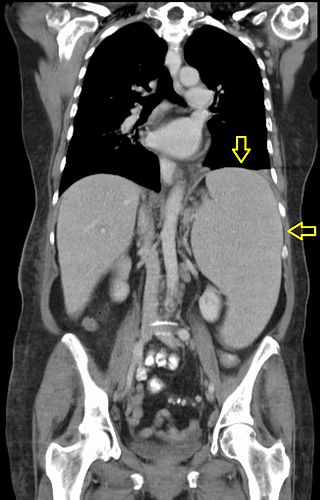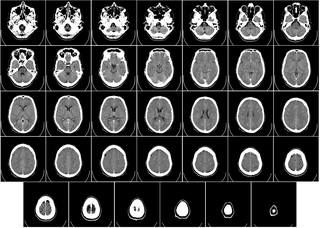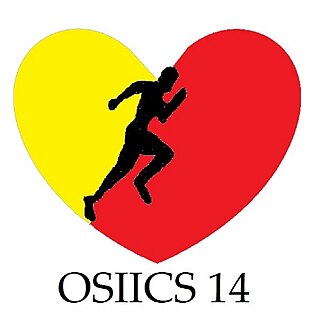Internal medicine or general internal medicine is the medical specialty dealing with the prevention, diagnosis, and treatment of internal diseases. Doctors specializing in internal medicine are called internists, or physicians in Commonwealth nations. Internists are medical specialists that are skilled in the management of patients who have undifferentiated or multi-system disease processes. Internists care for hospitalized (inpatient) and ambulatory (outpatient) patients and may play a major role in teaching and research. Internists are qualified physicians with postgraduate training in internal medicine and should not be confused with "interns", a term for doctors in their first year of residency training.

A concussion, also known as a mild traumatic brain injury (mTBI), is a head injury that temporarily affects brain functioning. Symptoms may include loss of consciousness (LOC); memory loss; headaches; difficulty with thinking, concentration, or balance; nausea; blurred vision; sleep disturbances, and mood changes. Any of these symptoms may begin immediately, or appear days after the injury. Concussion should be suspected if a person indirectly or directly hits their head and experiences any of the symptoms of concussion. It is not unusual for symptoms to last 2 weeks in adults and 4 weeks in children. Fewer than 10% of sports-related concussions among children are associated with loss of consciousness.

Orthopedic surgery or orthopedics, is the branch of surgery concerned with conditions involving the musculoskeletal system. Orthopedic surgeons use both surgical and nonsurgical means to treat musculoskeletal trauma, spine diseases, sports injuries, degenerative diseases, infections, tumors, and congenital disorders.

Splenomegaly is an enlargement of the spleen. The spleen usually lies in the left upper quadrant (LUQ) of the human abdomen. Splenomegaly is one of the four cardinal signs of hypersplenism which include: some reduction in number of circulating blood cells affecting granulocytes, erythrocytes or platelets in any combination; a compensatory proliferative response in the bone marrow; and the potential for correction of these abnormalities by splenectomy. Splenomegaly is usually associated with increased workload, which suggests that it is a response to hyperfunction. It is therefore not surprising that splenomegaly is associated with any disease process that involves abnormal red blood cells being destroyed in the spleen. Other common causes include congestion due to portal hypertension and infiltration by leukemias and lymphomas. Thus, the finding of an enlarged spleen, along with caput medusae, is an important sign of portal hypertension.

Sports medicine is a branch of medicine that deals with physical fitness and the treatment and prevention of injuries related to sports and exercise. Although most sports teams have employed team physicians for many years, it is only since the late 20th century that sports medicine emerged as a distinct field of health care. In some countries, sports medicine is a recognized medical specialty. In the majority of countries where sports medicine is recognized and practiced, it is a physician (non-surgical) specialty, but in some, it can equally be a surgical or non-surgical medical specialty, and also a specialty field within primary care. In other contexts, the field of sports medicine encompasses the scope of both medical specialists and also allied health practitioners who work in the field of sport, such as physiotherapists, athletic trainers, podiatrists and exercise physiologists.
Serial sevens, where a patient counts down from one hundred by sevens, is a clinical test used to test cognition; for example, to help assess mental status after possible head injury, in suspected cases of dementia or to show sleep inertia. This well-known test, in active documented use since at least 1944, was adopted as part of the mini-mental state examination. The test is also used in determining when a patient is becoming unconscious under anaesthetic, for example prior to major dental surgery.
Second-impact syndrome (SIS) occurs when the brain swells rapidly, and catastrophically, after a person has a second concussion before symptoms from an earlier one have subsided. This second blow may occur minutes, days, or weeks after an initial concussion, and even the mildest grade of concussion can lead to second impact syndrome. The condition is often fatal, and almost everyone who is not killed is severely disabled. The cause of SIS is uncertain, but it is thought that the brain's arterioles lose their ability to regulate their diameter, and therefore lose control over cerebral blood flow, causing massive cerebral edema.

The British Journal of Sports Medicine is a twice-monthly peer-reviewed medical journal covering sports science and sports medicine including sport physiotherapy. It is published by the BMJ Group. It was established in 1964 and the editor-in-chief from 2008 to 2020 was Karim M. Khan. Jonathan Drezner has been editor-in-chief since January 1, 2021.
The fencing response is an unnatural position of the arms following a concussion. Immediately after moderate forces have been applied to the brainstem, the forearms are held flexed or extended for a period lasting up to several seconds after the impact. The fencing response is often observed during athletic competition involving contact, such as combat sports, American football, Ice hockey, rugby union, rugby league and Australian rules football. It is used as an overt indicator of injury force magnitude and midbrain localization to aid in injury identification and classification for events including on-field and/or bystander observations of sports-related head injuries.

Computed tomography of the head uses a series of X-rays in a CT scan of the head taken from many different directions; the resulting data is transformed into a series of cross sections of the brain using a computer program. CT images of the head are used to investigate and diagnose brain injuries and other neurological conditions, as well as other conditions involving the skull or sinuses; it used to guide some brain surgery procedures as well. CT scans expose the person getting them to ionizing radiation which has a risk of eventually causing cancer; some people have allergic reactions to contrast agents that are used in some CT procedures.

Helmet-to-helmet collisions are occurrences in gridiron football when two players' football helmets make head-to-head contact with a high degree of force. Intentionally causing a helmet-to-helmet collision is a penalty in most football leagues, including many high school leagues.
Health issues of athletics concern the health and well-being of athletes who participate in an organized sport. If athletes are physically and mentally underdeveloped, they are susceptible to mental or physical problems. Athletes trying to improve their performance in sports can harm themselves by overtraining, adopting eating habits that damage them physically or psychologically, and using steroids or supplements.
Exercise-associated hyponatremia, is a fluid-electrolyte disorder caused by a decrease in sodium levels (hyponatremia) during or up to 24 hours after prolonged physical activity. This disorder can develop when marathon runners or endurance event athletes drink more fluid, usually water or sports drinks, than their kidneys can excrete. This excess water can severely dilute the level of sodium in the blood needed for organs, especially the brain, to function properly.

The Australasian College of Sport and Exercise Physicians (ACSEP) is a not-for-profit professional organisation responsible for training, educating, and representing over 350 doctors in Australia and New Zealand. These doctors practise medicine in the specialty of sport and exercise medicine (SEM). The ACSEP is the smallest of the 15 recognised specialist medical Colleges in Australia with approximately 260 Fellows and Registrars in 2020.

Sports cardiology is an emerging subspecialty field of Cardiology. It may also be considered a subspecialty field of Sports medicine, or alternatively a hybrid subspecialty that spans cardiology and sports medicine. Emergency medicine is another medical specialty that has some overlap with Sports Cardiology. Sports cardiology is now considered to be a distinct subspecialty in Europe and the USA, with a core curriculum developed in both regions. In Europe it has traditionally been grouped under Preventive Cardiology, but the subspecialty of Sports Cardiology is now considered a distinct field. In the USA, it has developed from being a special interest area to a distinct subspecialty as well.

Jonathan A. Drezner is an American sport and exercise medicine physician, currently editor in chief of the British Journal of Sports Medicine. In both clinical practice and research he has a strong interest in sports cardiology. He is a first author for the International Guidelines for Electrocardiography (ECG) Interpretation in athletes and was the 19th President of the American Medical Society for Sports Medicine (AMSSM) in 2012.

A medial epicondyle fracture is an avulsion injury to the medial epicondyle of the humerus; the prominence of bone on the inside of the elbow. Medial epicondyle fractures account for 10% elbow fractures in children. 25% of injuries are associated with a dislocation of the elbow.
The American Medical Society for Sports Medicine (AMSSM) is a large sports medicine membership organization, representing over 3000 physicians in the United States, established in 1991. AMSSM includes members who serve as team physicians at the youth level, NCAA, NFL, MLB, NBA, WNBA, MLS, and NHL, as well as with Olympic and Paralympic teams.
The Cogstate Brief Battery (CBB) is a computer-based cognitive assessment used in clinical trials, healthcare, and academic research to measure neurological cognition., developed by Cogstate Ltd.

The Orchard Sports Injury and Illness Classification System (OSIICS), previously OSICS, is an injury classification system for sports injuries and illnesses. It was first created in 1993 and is free for sporting teams and competitions to use. It is one of the two major Sports Injury classification systems in use worldwide; the other is the Sports Medicine Diagnostic Coding System.











